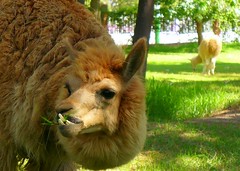Llamas, Alpacas, Vicuñas and Guanacos
 Living on the altiplano – the Andean plateau – are the South American camelids. Llamas and Alpacas found themselves domesticated by humans and have lived this way for as much as 6000 years. Guanacos and Vicuñas on the other hand still exist in the wild and are heavily protected by law. They are all somehow able to thrive on the tough vegetation and harsh extremes in temperatures that we find at these altitudes. Although these species are distinct, they are close enough to interbreed.
Living on the altiplano – the Andean plateau – are the South American camelids. Llamas and Alpacas found themselves domesticated by humans and have lived this way for as much as 6000 years. Guanacos and Vicuñas on the other hand still exist in the wild and are heavily protected by law. They are all somehow able to thrive on the tough vegetation and harsh extremes in temperatures that we find at these altitudes. Although these species are distinct, they are close enough to interbreed.
In fact, it’s probably due to the work of ancient humans that the four exist. Some researchers believe that it was selective breeding that brought the differences into existence.
Pre-Inca cultures used camelids for food and clothing before beginning to herd them. By the time of the Incas, selective breeding was known for sure to have been taking place. Distinct breeds of llamas and alpacas had come about, and these were separated further into colours and fur lengths.
When the Spanish arrived in Peru, they found civilisations based on textiles, not metals as they were in the old world. Textiles were used for everything, from clothing, to currency and even heavy engineering in the form of bridge construction. Debts, rewards and military salaries were paid in woven textiles with ever more complicated patterns.
To the native peoples, alpacas were considered divine gifts from Pachamama, mother earth, given to them on the condition that humans were to care for and respect these animals.
The Spanish, however, were only interested in gold. They slaughtered alpacas and llamas in an effort to subjugate the native people, banning their traditional weaving and uses for alpaca fur. It is estimated that as many as 90% of all alpacas and llamas in South America were systematically killed. Carefully bred herds, divided by colour and quality were killed or dispersed.
The animals we have today are the descendants of those hidden by natives out of the reaches of the Spanish conquerors. Many different breeds still exist, but so too do many mix breeds. The results of the careful selective breeding of the pre-Hispanic civilisations has been lost forever.
Tags: alpaca, guanacos, incas, llamas, pachamama, spaniards, textiles, vicuñas, weaving










